Report on Anatomy and Physiology
VerifiedAdded on 2022/08/14
|14
|4746
|21
AI Summary
Contribute Materials
Your contribution can guide someone’s learning journey. Share your
documents today.

Running head: REPORT
Anatomy and physiology
Name of the Student
Name of the University
Author Note
Anatomy and physiology
Name of the Student
Name of the University
Author Note
Secure Best Marks with AI Grader
Need help grading? Try our AI Grader for instant feedback on your assignments.
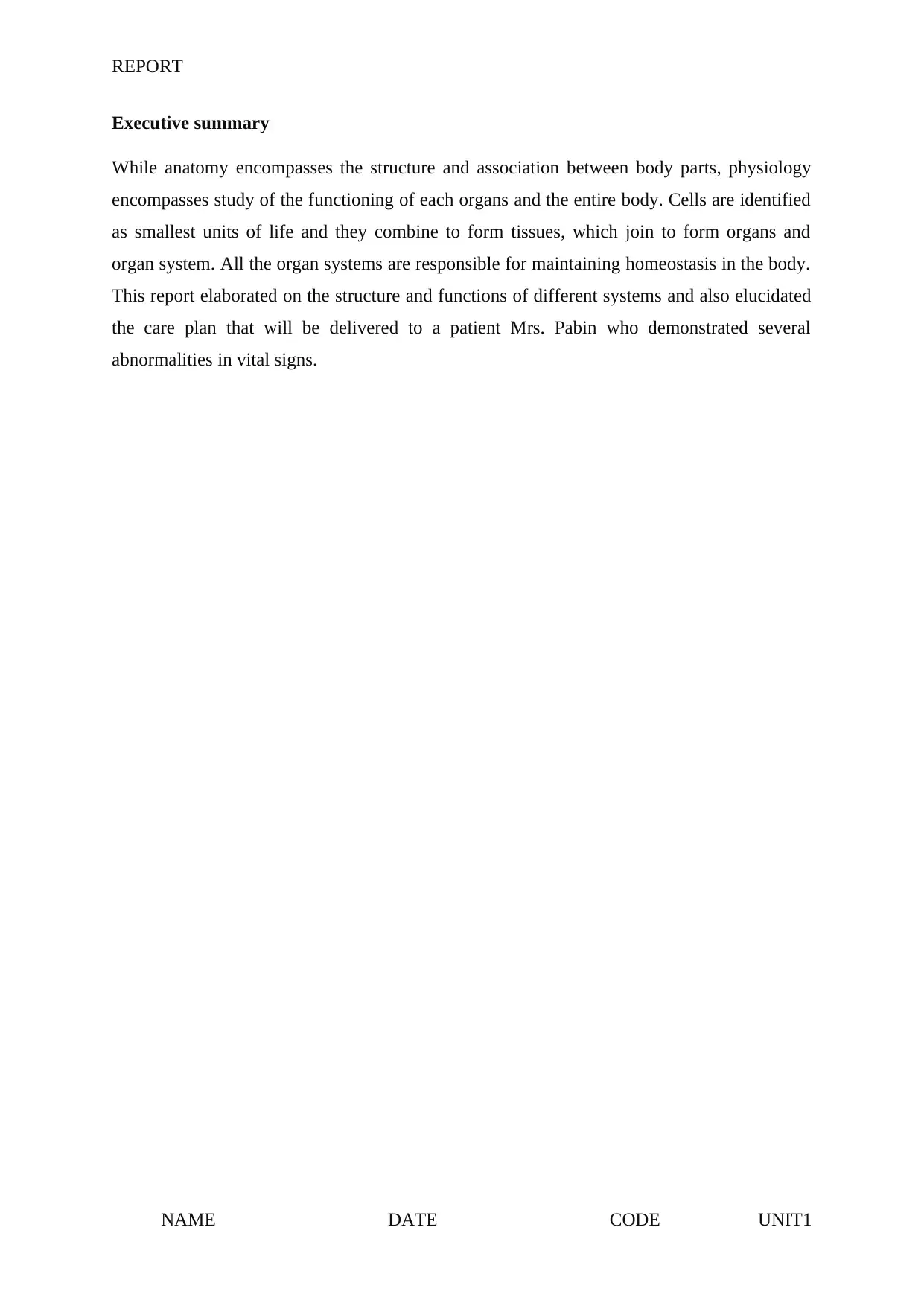
REPORT
Executive summary
While anatomy encompasses the structure and association between body parts, physiology
encompasses study of the functioning of each organs and the entire body. Cells are identified
as smallest units of life and they combine to form tissues, which join to form organs and
organ system. All the organ systems are responsible for maintaining homeostasis in the body.
This report elaborated on the structure and functions of different systems and also elucidated
the care plan that will be delivered to a patient Mrs. Pabin who demonstrated several
abnormalities in vital signs.
NAME DATE CODE UNIT1
Executive summary
While anatomy encompasses the structure and association between body parts, physiology
encompasses study of the functioning of each organs and the entire body. Cells are identified
as smallest units of life and they combine to form tissues, which join to form organs and
organ system. All the organ systems are responsible for maintaining homeostasis in the body.
This report elaborated on the structure and functions of different systems and also elucidated
the care plan that will be delivered to a patient Mrs. Pabin who demonstrated several
abnormalities in vital signs.
NAME DATE CODE UNIT1

REPORT
Table of Contents
Part 1..........................................................................................................................................3
Introduction............................................................................................................................3
Organ systems........................................................................................................................3
Interrelationship of body systems..........................................................................................5
Conclusion..............................................................................................................................6
Part 2..........................................................................................................................................7
Introduction............................................................................................................................7
Impact of ill health on physiological measurements..............................................................7
Risk assessment and care interventions.................................................................................8
Conclusion............................................................................................................................10
References................................................................................................................................12
NAME DATE CODE UNIT2
Table of Contents
Part 1..........................................................................................................................................3
Introduction............................................................................................................................3
Organ systems........................................................................................................................3
Interrelationship of body systems..........................................................................................5
Conclusion..............................................................................................................................6
Part 2..........................................................................................................................................7
Introduction............................................................................................................................7
Impact of ill health on physiological measurements..............................................................7
Risk assessment and care interventions.................................................................................8
Conclusion............................................................................................................................10
References................................................................................................................................12
NAME DATE CODE UNIT2
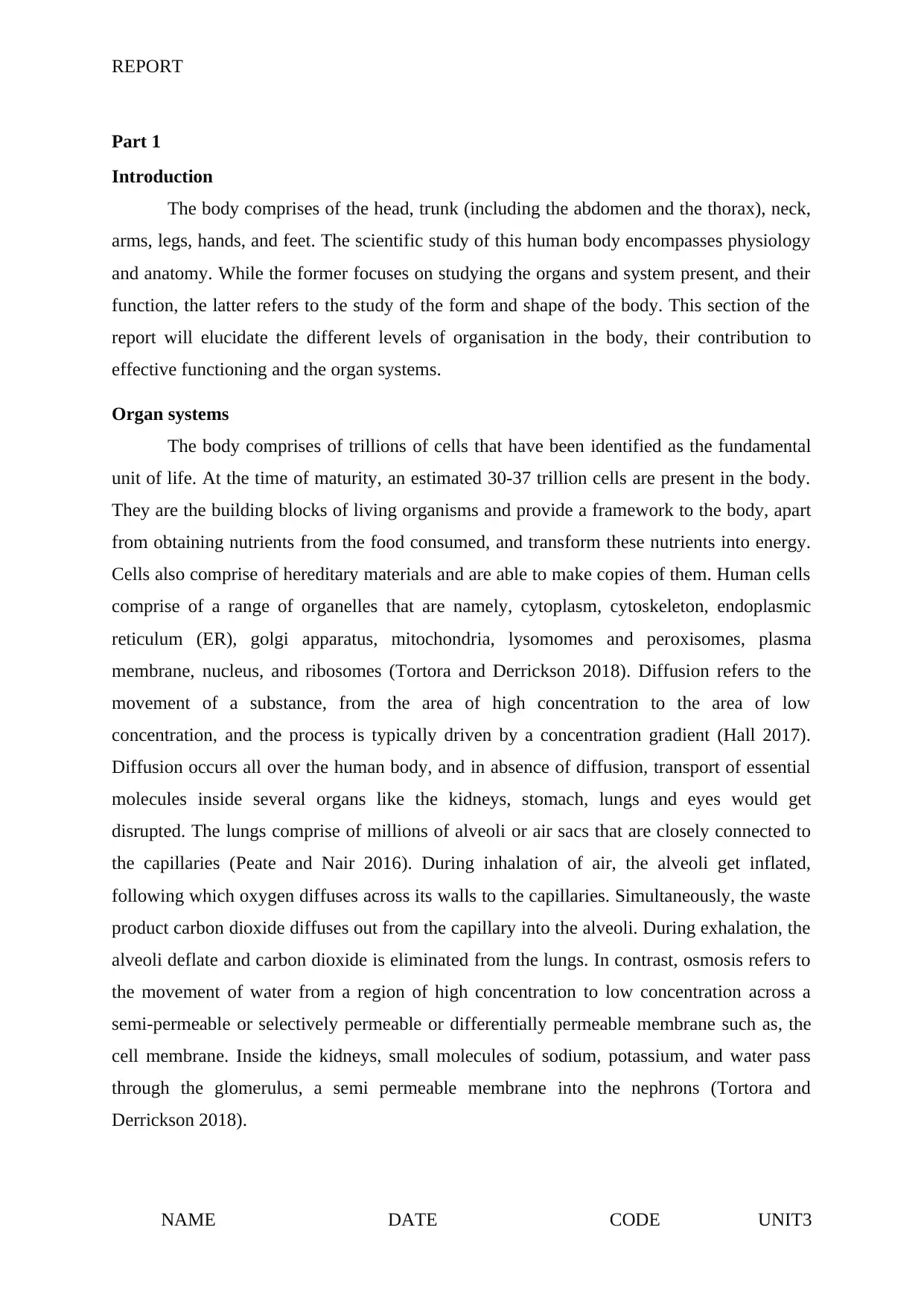
REPORT
Part 1
Introduction
The body comprises of the head, trunk (including the abdomen and the thorax), neck,
arms, legs, hands, and feet. The scientific study of this human body encompasses physiology
and anatomy. While the former focuses on studying the organs and system present, and their
function, the latter refers to the study of the form and shape of the body. This section of the
report will elucidate the different levels of organisation in the body, their contribution to
effective functioning and the organ systems.
Organ systems
The body comprises of trillions of cells that have been identified as the fundamental
unit of life. At the time of maturity, an estimated 30-37 trillion cells are present in the body.
They are the building blocks of living organisms and provide a framework to the body, apart
from obtaining nutrients from the food consumed, and transform these nutrients into energy.
Cells also comprise of hereditary materials and are able to make copies of them. Human cells
comprise of a range of organelles that are namely, cytoplasm, cytoskeleton, endoplasmic
reticulum (ER), golgi apparatus, mitochondria, lysomomes and peroxisomes, plasma
membrane, nucleus, and ribosomes (Tortora and Derrickson 2018). Diffusion refers to the
movement of a substance, from the area of high concentration to the area of low
concentration, and the process is typically driven by a concentration gradient (Hall 2017).
Diffusion occurs all over the human body, and in absence of diffusion, transport of essential
molecules inside several organs like the kidneys, stomach, lungs and eyes would get
disrupted. The lungs comprise of millions of alveoli or air sacs that are closely connected to
the capillaries (Peate and Nair 2016). During inhalation of air, the alveoli get inflated,
following which oxygen diffuses across its walls to the capillaries. Simultaneously, the waste
product carbon dioxide diffuses out from the capillary into the alveoli. During exhalation, the
alveoli deflate and carbon dioxide is eliminated from the lungs. In contrast, osmosis refers to
the movement of water from a region of high concentration to low concentration across a
semi-permeable or selectively permeable or differentially permeable membrane such as, the
cell membrane. Inside the kidneys, small molecules of sodium, potassium, and water pass
through the glomerulus, a semi permeable membrane into the nephrons (Tortora and
Derrickson 2018).
NAME DATE CODE UNIT3
Part 1
Introduction
The body comprises of the head, trunk (including the abdomen and the thorax), neck,
arms, legs, hands, and feet. The scientific study of this human body encompasses physiology
and anatomy. While the former focuses on studying the organs and system present, and their
function, the latter refers to the study of the form and shape of the body. This section of the
report will elucidate the different levels of organisation in the body, their contribution to
effective functioning and the organ systems.
Organ systems
The body comprises of trillions of cells that have been identified as the fundamental
unit of life. At the time of maturity, an estimated 30-37 trillion cells are present in the body.
They are the building blocks of living organisms and provide a framework to the body, apart
from obtaining nutrients from the food consumed, and transform these nutrients into energy.
Cells also comprise of hereditary materials and are able to make copies of them. Human cells
comprise of a range of organelles that are namely, cytoplasm, cytoskeleton, endoplasmic
reticulum (ER), golgi apparatus, mitochondria, lysomomes and peroxisomes, plasma
membrane, nucleus, and ribosomes (Tortora and Derrickson 2018). Diffusion refers to the
movement of a substance, from the area of high concentration to the area of low
concentration, and the process is typically driven by a concentration gradient (Hall 2017).
Diffusion occurs all over the human body, and in absence of diffusion, transport of essential
molecules inside several organs like the kidneys, stomach, lungs and eyes would get
disrupted. The lungs comprise of millions of alveoli or air sacs that are closely connected to
the capillaries (Peate and Nair 2016). During inhalation of air, the alveoli get inflated,
following which oxygen diffuses across its walls to the capillaries. Simultaneously, the waste
product carbon dioxide diffuses out from the capillary into the alveoli. During exhalation, the
alveoli deflate and carbon dioxide is eliminated from the lungs. In contrast, osmosis refers to
the movement of water from a region of high concentration to low concentration across a
semi-permeable or selectively permeable or differentially permeable membrane such as, the
cell membrane. Inside the kidneys, small molecules of sodium, potassium, and water pass
through the glomerulus, a semi permeable membrane into the nephrons (Tortora and
Derrickson 2018).
NAME DATE CODE UNIT3
Secure Best Marks with AI Grader
Need help grading? Try our AI Grader for instant feedback on your assignments.
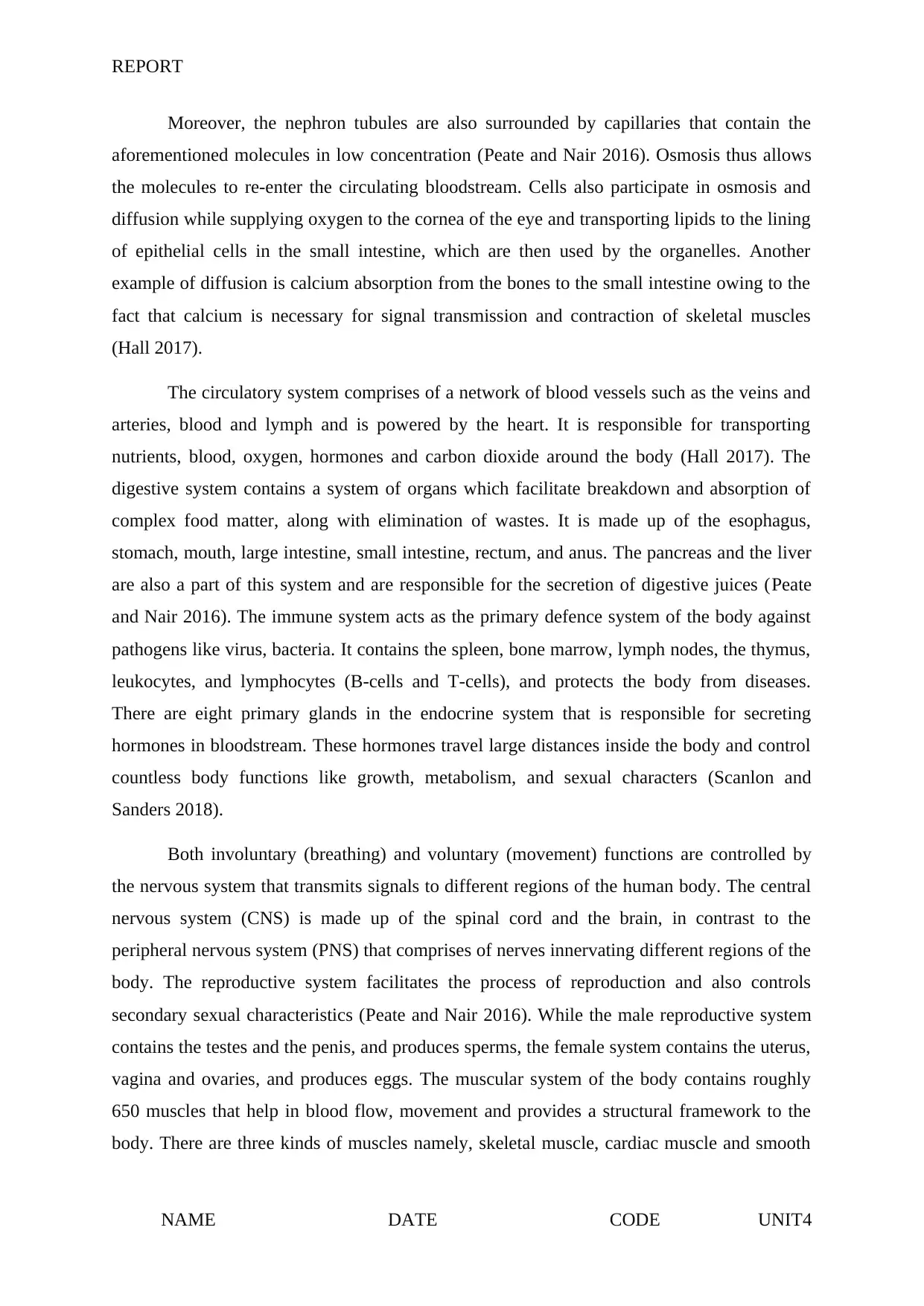
REPORT
Moreover, the nephron tubules are also surrounded by capillaries that contain the
aforementioned molecules in low concentration (Peate and Nair 2016). Osmosis thus allows
the molecules to re-enter the circulating bloodstream. Cells also participate in osmosis and
diffusion while supplying oxygen to the cornea of the eye and transporting lipids to the lining
of epithelial cells in the small intestine, which are then used by the organelles. Another
example of diffusion is calcium absorption from the bones to the small intestine owing to the
fact that calcium is necessary for signal transmission and contraction of skeletal muscles
(Hall 2017).
The circulatory system comprises of a network of blood vessels such as the veins and
arteries, blood and lymph and is powered by the heart. It is responsible for transporting
nutrients, blood, oxygen, hormones and carbon dioxide around the body (Hall 2017). The
digestive system contains a system of organs which facilitate breakdown and absorption of
complex food matter, along with elimination of wastes. It is made up of the esophagus,
stomach, mouth, large intestine, small intestine, rectum, and anus. The pancreas and the liver
are also a part of this system and are responsible for the secretion of digestive juices (Peate
and Nair 2016). The immune system acts as the primary defence system of the body against
pathogens like virus, bacteria. It contains the spleen, bone marrow, lymph nodes, the thymus,
leukocytes, and lymphocytes (B-cells and T-cells), and protects the body from diseases.
There are eight primary glands in the endocrine system that is responsible for secreting
hormones in bloodstream. These hormones travel large distances inside the body and control
countless body functions like growth, metabolism, and sexual characters (Scanlon and
Sanders 2018).
Both involuntary (breathing) and voluntary (movement) functions are controlled by
the nervous system that transmits signals to different regions of the human body. The central
nervous system (CNS) is made up of the spinal cord and the brain, in contrast to the
peripheral nervous system (PNS) that comprises of nerves innervating different regions of the
body. The reproductive system facilitates the process of reproduction and also controls
secondary sexual characteristics (Peate and Nair 2016). While the male reproductive system
contains the testes and the penis, and produces sperms, the female system contains the uterus,
vagina and ovaries, and produces eggs. The muscular system of the body contains roughly
650 muscles that help in blood flow, movement and provides a structural framework to the
body. There are three kinds of muscles namely, skeletal muscle, cardiac muscle and smooth
NAME DATE CODE UNIT4
Moreover, the nephron tubules are also surrounded by capillaries that contain the
aforementioned molecules in low concentration (Peate and Nair 2016). Osmosis thus allows
the molecules to re-enter the circulating bloodstream. Cells also participate in osmosis and
diffusion while supplying oxygen to the cornea of the eye and transporting lipids to the lining
of epithelial cells in the small intestine, which are then used by the organelles. Another
example of diffusion is calcium absorption from the bones to the small intestine owing to the
fact that calcium is necessary for signal transmission and contraction of skeletal muscles
(Hall 2017).
The circulatory system comprises of a network of blood vessels such as the veins and
arteries, blood and lymph and is powered by the heart. It is responsible for transporting
nutrients, blood, oxygen, hormones and carbon dioxide around the body (Hall 2017). The
digestive system contains a system of organs which facilitate breakdown and absorption of
complex food matter, along with elimination of wastes. It is made up of the esophagus,
stomach, mouth, large intestine, small intestine, rectum, and anus. The pancreas and the liver
are also a part of this system and are responsible for the secretion of digestive juices (Peate
and Nair 2016). The immune system acts as the primary defence system of the body against
pathogens like virus, bacteria. It contains the spleen, bone marrow, lymph nodes, the thymus,
leukocytes, and lymphocytes (B-cells and T-cells), and protects the body from diseases.
There are eight primary glands in the endocrine system that is responsible for secreting
hormones in bloodstream. These hormones travel large distances inside the body and control
countless body functions like growth, metabolism, and sexual characters (Scanlon and
Sanders 2018).
Both involuntary (breathing) and voluntary (movement) functions are controlled by
the nervous system that transmits signals to different regions of the human body. The central
nervous system (CNS) is made up of the spinal cord and the brain, in contrast to the
peripheral nervous system (PNS) that comprises of nerves innervating different regions of the
body. The reproductive system facilitates the process of reproduction and also controls
secondary sexual characteristics (Peate and Nair 2016). While the male reproductive system
contains the testes and the penis, and produces sperms, the female system contains the uterus,
vagina and ovaries, and produces eggs. The muscular system of the body contains roughly
650 muscles that help in blood flow, movement and provides a structural framework to the
body. There are three kinds of muscles namely, skeletal muscle, cardiac muscle and smooth
NAME DATE CODE UNIT4
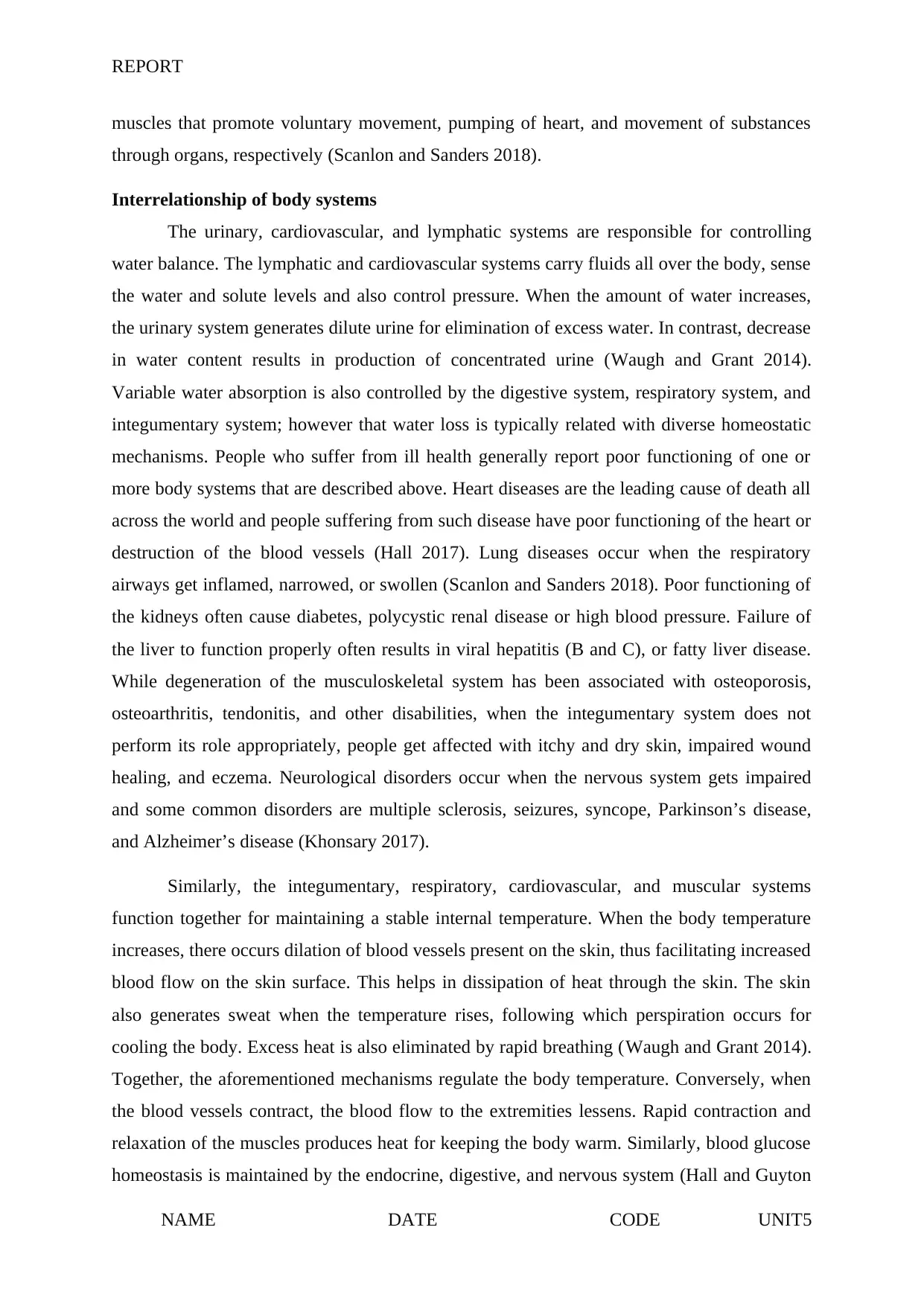
REPORT
muscles that promote voluntary movement, pumping of heart, and movement of substances
through organs, respectively (Scanlon and Sanders 2018).
Interrelationship of body systems
The urinary, cardiovascular, and lymphatic systems are responsible for controlling
water balance. The lymphatic and cardiovascular systems carry fluids all over the body, sense
the water and solute levels and also control pressure. When the amount of water increases,
the urinary system generates dilute urine for elimination of excess water. In contrast, decrease
in water content results in production of concentrated urine (Waugh and Grant 2014).
Variable water absorption is also controlled by the digestive system, respiratory system, and
integumentary system; however that water loss is typically related with diverse homeostatic
mechanisms. People who suffer from ill health generally report poor functioning of one or
more body systems that are described above. Heart diseases are the leading cause of death all
across the world and people suffering from such disease have poor functioning of the heart or
destruction of the blood vessels (Hall 2017). Lung diseases occur when the respiratory
airways get inflamed, narrowed, or swollen (Scanlon and Sanders 2018). Poor functioning of
the kidneys often cause diabetes, polycystic renal disease or high blood pressure. Failure of
the liver to function properly often results in viral hepatitis (B and C), or fatty liver disease.
While degeneration of the musculoskeletal system has been associated with osteoporosis,
osteoarthritis, tendonitis, and other disabilities, when the integumentary system does not
perform its role appropriately, people get affected with itchy and dry skin, impaired wound
healing, and eczema. Neurological disorders occur when the nervous system gets impaired
and some common disorders are multiple sclerosis, seizures, syncope, Parkinson’s disease,
and Alzheimer’s disease (Khonsary 2017).
Similarly, the integumentary, respiratory, cardiovascular, and muscular systems
function together for maintaining a stable internal temperature. When the body temperature
increases, there occurs dilation of blood vessels present on the skin, thus facilitating increased
blood flow on the skin surface. This helps in dissipation of heat through the skin. The skin
also generates sweat when the temperature rises, following which perspiration occurs for
cooling the body. Excess heat is also eliminated by rapid breathing (Waugh and Grant 2014).
Together, the aforementioned mechanisms regulate the body temperature. Conversely, when
the blood vessels contract, the blood flow to the extremities lessens. Rapid contraction and
relaxation of the muscles produces heat for keeping the body warm. Similarly, blood glucose
homeostasis is maintained by the endocrine, digestive, and nervous system (Hall and Guyton
NAME DATE CODE UNIT5
muscles that promote voluntary movement, pumping of heart, and movement of substances
through organs, respectively (Scanlon and Sanders 2018).
Interrelationship of body systems
The urinary, cardiovascular, and lymphatic systems are responsible for controlling
water balance. The lymphatic and cardiovascular systems carry fluids all over the body, sense
the water and solute levels and also control pressure. When the amount of water increases,
the urinary system generates dilute urine for elimination of excess water. In contrast, decrease
in water content results in production of concentrated urine (Waugh and Grant 2014).
Variable water absorption is also controlled by the digestive system, respiratory system, and
integumentary system; however that water loss is typically related with diverse homeostatic
mechanisms. People who suffer from ill health generally report poor functioning of one or
more body systems that are described above. Heart diseases are the leading cause of death all
across the world and people suffering from such disease have poor functioning of the heart or
destruction of the blood vessels (Hall 2017). Lung diseases occur when the respiratory
airways get inflamed, narrowed, or swollen (Scanlon and Sanders 2018). Poor functioning of
the kidneys often cause diabetes, polycystic renal disease or high blood pressure. Failure of
the liver to function properly often results in viral hepatitis (B and C), or fatty liver disease.
While degeneration of the musculoskeletal system has been associated with osteoporosis,
osteoarthritis, tendonitis, and other disabilities, when the integumentary system does not
perform its role appropriately, people get affected with itchy and dry skin, impaired wound
healing, and eczema. Neurological disorders occur when the nervous system gets impaired
and some common disorders are multiple sclerosis, seizures, syncope, Parkinson’s disease,
and Alzheimer’s disease (Khonsary 2017).
Similarly, the integumentary, respiratory, cardiovascular, and muscular systems
function together for maintaining a stable internal temperature. When the body temperature
increases, there occurs dilation of blood vessels present on the skin, thus facilitating increased
blood flow on the skin surface. This helps in dissipation of heat through the skin. The skin
also generates sweat when the temperature rises, following which perspiration occurs for
cooling the body. Excess heat is also eliminated by rapid breathing (Waugh and Grant 2014).
Together, the aforementioned mechanisms regulate the body temperature. Conversely, when
the blood vessels contract, the blood flow to the extremities lessens. Rapid contraction and
relaxation of the muscles produces heat for keeping the body warm. Similarly, blood glucose
homeostasis is maintained by the endocrine, digestive, and nervous system (Hall and Guyton
NAME DATE CODE UNIT5
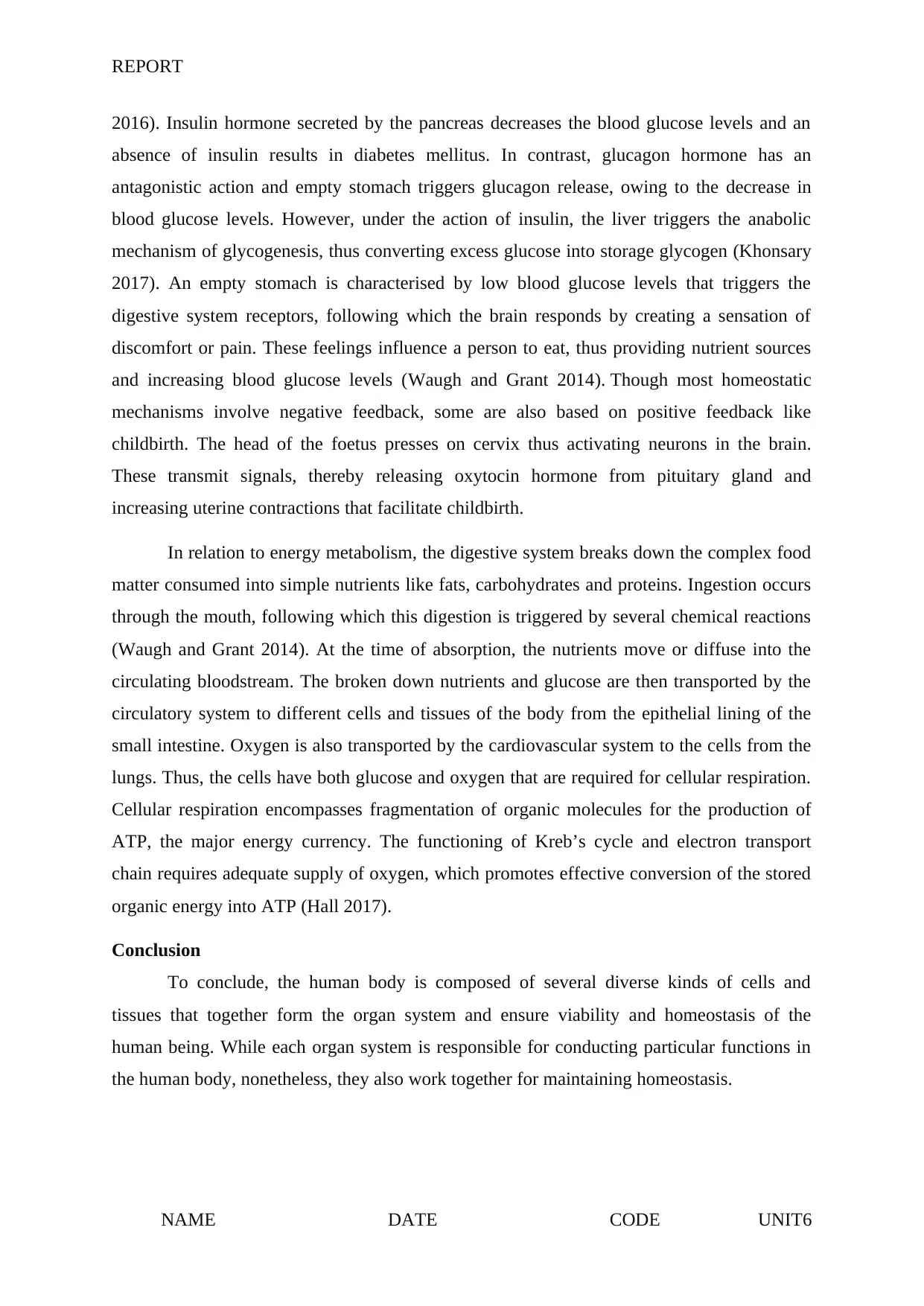
REPORT
2016). Insulin hormone secreted by the pancreas decreases the blood glucose levels and an
absence of insulin results in diabetes mellitus. In contrast, glucagon hormone has an
antagonistic action and empty stomach triggers glucagon release, owing to the decrease in
blood glucose levels. However, under the action of insulin, the liver triggers the anabolic
mechanism of glycogenesis, thus converting excess glucose into storage glycogen (Khonsary
2017). An empty stomach is characterised by low blood glucose levels that triggers the
digestive system receptors, following which the brain responds by creating a sensation of
discomfort or pain. These feelings influence a person to eat, thus providing nutrient sources
and increasing blood glucose levels (Waugh and Grant 2014). Though most homeostatic
mechanisms involve negative feedback, some are also based on positive feedback like
childbirth. The head of the foetus presses on cervix thus activating neurons in the brain.
These transmit signals, thereby releasing oxytocin hormone from pituitary gland and
increasing uterine contractions that facilitate childbirth.
In relation to energy metabolism, the digestive system breaks down the complex food
matter consumed into simple nutrients like fats, carbohydrates and proteins. Ingestion occurs
through the mouth, following which this digestion is triggered by several chemical reactions
(Waugh and Grant 2014). At the time of absorption, the nutrients move or diffuse into the
circulating bloodstream. The broken down nutrients and glucose are then transported by the
circulatory system to different cells and tissues of the body from the epithelial lining of the
small intestine. Oxygen is also transported by the cardiovascular system to the cells from the
lungs. Thus, the cells have both glucose and oxygen that are required for cellular respiration.
Cellular respiration encompasses fragmentation of organic molecules for the production of
ATP, the major energy currency. The functioning of Kreb’s cycle and electron transport
chain requires adequate supply of oxygen, which promotes effective conversion of the stored
organic energy into ATP (Hall 2017).
Conclusion
To conclude, the human body is composed of several diverse kinds of cells and
tissues that together form the organ system and ensure viability and homeostasis of the
human being. While each organ system is responsible for conducting particular functions in
the human body, nonetheless, they also work together for maintaining homeostasis.
NAME DATE CODE UNIT6
2016). Insulin hormone secreted by the pancreas decreases the blood glucose levels and an
absence of insulin results in diabetes mellitus. In contrast, glucagon hormone has an
antagonistic action and empty stomach triggers glucagon release, owing to the decrease in
blood glucose levels. However, under the action of insulin, the liver triggers the anabolic
mechanism of glycogenesis, thus converting excess glucose into storage glycogen (Khonsary
2017). An empty stomach is characterised by low blood glucose levels that triggers the
digestive system receptors, following which the brain responds by creating a sensation of
discomfort or pain. These feelings influence a person to eat, thus providing nutrient sources
and increasing blood glucose levels (Waugh and Grant 2014). Though most homeostatic
mechanisms involve negative feedback, some are also based on positive feedback like
childbirth. The head of the foetus presses on cervix thus activating neurons in the brain.
These transmit signals, thereby releasing oxytocin hormone from pituitary gland and
increasing uterine contractions that facilitate childbirth.
In relation to energy metabolism, the digestive system breaks down the complex food
matter consumed into simple nutrients like fats, carbohydrates and proteins. Ingestion occurs
through the mouth, following which this digestion is triggered by several chemical reactions
(Waugh and Grant 2014). At the time of absorption, the nutrients move or diffuse into the
circulating bloodstream. The broken down nutrients and glucose are then transported by the
circulatory system to different cells and tissues of the body from the epithelial lining of the
small intestine. Oxygen is also transported by the cardiovascular system to the cells from the
lungs. Thus, the cells have both glucose and oxygen that are required for cellular respiration.
Cellular respiration encompasses fragmentation of organic molecules for the production of
ATP, the major energy currency. The functioning of Kreb’s cycle and electron transport
chain requires adequate supply of oxygen, which promotes effective conversion of the stored
organic energy into ATP (Hall 2017).
Conclusion
To conclude, the human body is composed of several diverse kinds of cells and
tissues that together form the organ system and ensure viability and homeostasis of the
human being. While each organ system is responsible for conducting particular functions in
the human body, nonetheless, they also work together for maintaining homeostasis.
NAME DATE CODE UNIT6
Paraphrase This Document
Need a fresh take? Get an instant paraphrase of this document with our AI Paraphraser
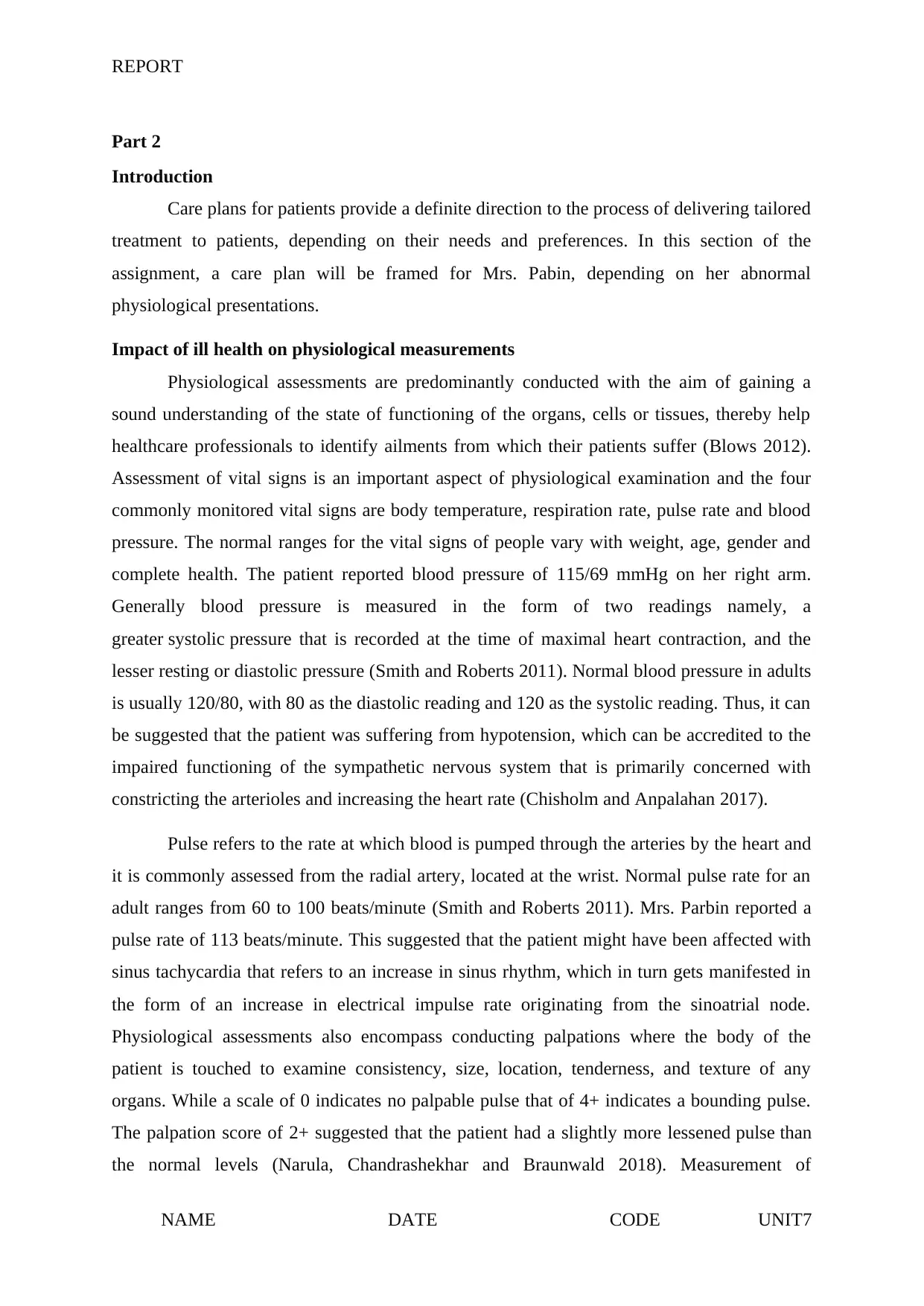
REPORT
Part 2
Introduction
Care plans for patients provide a definite direction to the process of delivering tailored
treatment to patients, depending on their needs and preferences. In this section of the
assignment, a care plan will be framed for Mrs. Pabin, depending on her abnormal
physiological presentations.
Impact of ill health on physiological measurements
Physiological assessments are predominantly conducted with the aim of gaining a
sound understanding of the state of functioning of the organs, cells or tissues, thereby help
healthcare professionals to identify ailments from which their patients suffer (Blows 2012).
Assessment of vital signs is an important aspect of physiological examination and the four
commonly monitored vital signs are body temperature, respiration rate, pulse rate and blood
pressure. The normal ranges for the vital signs of people vary with weight, age, gender and
complete health. The patient reported blood pressure of 115/69 mmHg on her right arm.
Generally blood pressure is measured in the form of two readings namely, a
greater systolic pressure that is recorded at the time of maximal heart contraction, and the
lesser resting or diastolic pressure (Smith and Roberts 2011). Normal blood pressure in adults
is usually 120/80, with 80 as the diastolic reading and 120 as the systolic reading. Thus, it can
be suggested that the patient was suffering from hypotension, which can be accredited to the
impaired functioning of the sympathetic nervous system that is primarily concerned with
constricting the arterioles and increasing the heart rate (Chisholm and Anpalahan 2017).
Pulse refers to the rate at which blood is pumped through the arteries by the heart and
it is commonly assessed from the radial artery, located at the wrist. Normal pulse rate for an
adult ranges from 60 to 100 beats/minute (Smith and Roberts 2011). Mrs. Parbin reported a
pulse rate of 113 beats/minute. This suggested that the patient might have been affected with
sinus tachycardia that refers to an increase in sinus rhythm, which in turn gets manifested in
the form of an increase in electrical impulse rate originating from the sinoatrial node.
Physiological assessments also encompass conducting palpations where the body of the
patient is touched to examine consistency, size, location, tenderness, and texture of any
organs. While a scale of 0 indicates no palpable pulse that of 4+ indicates a bounding pulse.
The palpation score of 2+ suggested that the patient had a slightly more lessened pulse than
the normal levels (Narula, Chandrashekhar and Braunwald 2018). Measurement of
NAME DATE CODE UNIT7
Part 2
Introduction
Care plans for patients provide a definite direction to the process of delivering tailored
treatment to patients, depending on their needs and preferences. In this section of the
assignment, a care plan will be framed for Mrs. Pabin, depending on her abnormal
physiological presentations.
Impact of ill health on physiological measurements
Physiological assessments are predominantly conducted with the aim of gaining a
sound understanding of the state of functioning of the organs, cells or tissues, thereby help
healthcare professionals to identify ailments from which their patients suffer (Blows 2012).
Assessment of vital signs is an important aspect of physiological examination and the four
commonly monitored vital signs are body temperature, respiration rate, pulse rate and blood
pressure. The normal ranges for the vital signs of people vary with weight, age, gender and
complete health. The patient reported blood pressure of 115/69 mmHg on her right arm.
Generally blood pressure is measured in the form of two readings namely, a
greater systolic pressure that is recorded at the time of maximal heart contraction, and the
lesser resting or diastolic pressure (Smith and Roberts 2011). Normal blood pressure in adults
is usually 120/80, with 80 as the diastolic reading and 120 as the systolic reading. Thus, it can
be suggested that the patient was suffering from hypotension, which can be accredited to the
impaired functioning of the sympathetic nervous system that is primarily concerned with
constricting the arterioles and increasing the heart rate (Chisholm and Anpalahan 2017).
Pulse refers to the rate at which blood is pumped through the arteries by the heart and
it is commonly assessed from the radial artery, located at the wrist. Normal pulse rate for an
adult ranges from 60 to 100 beats/minute (Smith and Roberts 2011). Mrs. Parbin reported a
pulse rate of 113 beats/minute. This suggested that the patient might have been affected with
sinus tachycardia that refers to an increase in sinus rhythm, which in turn gets manifested in
the form of an increase in electrical impulse rate originating from the sinoatrial node.
Physiological assessments also encompass conducting palpations where the body of the
patient is touched to examine consistency, size, location, tenderness, and texture of any
organs. While a scale of 0 indicates no palpable pulse that of 4+ indicates a bounding pulse.
The palpation score of 2+ suggested that the patient had a slightly more lessened pulse than
the normal levels (Narula, Chandrashekhar and Braunwald 2018). Measurement of
NAME DATE CODE UNIT7
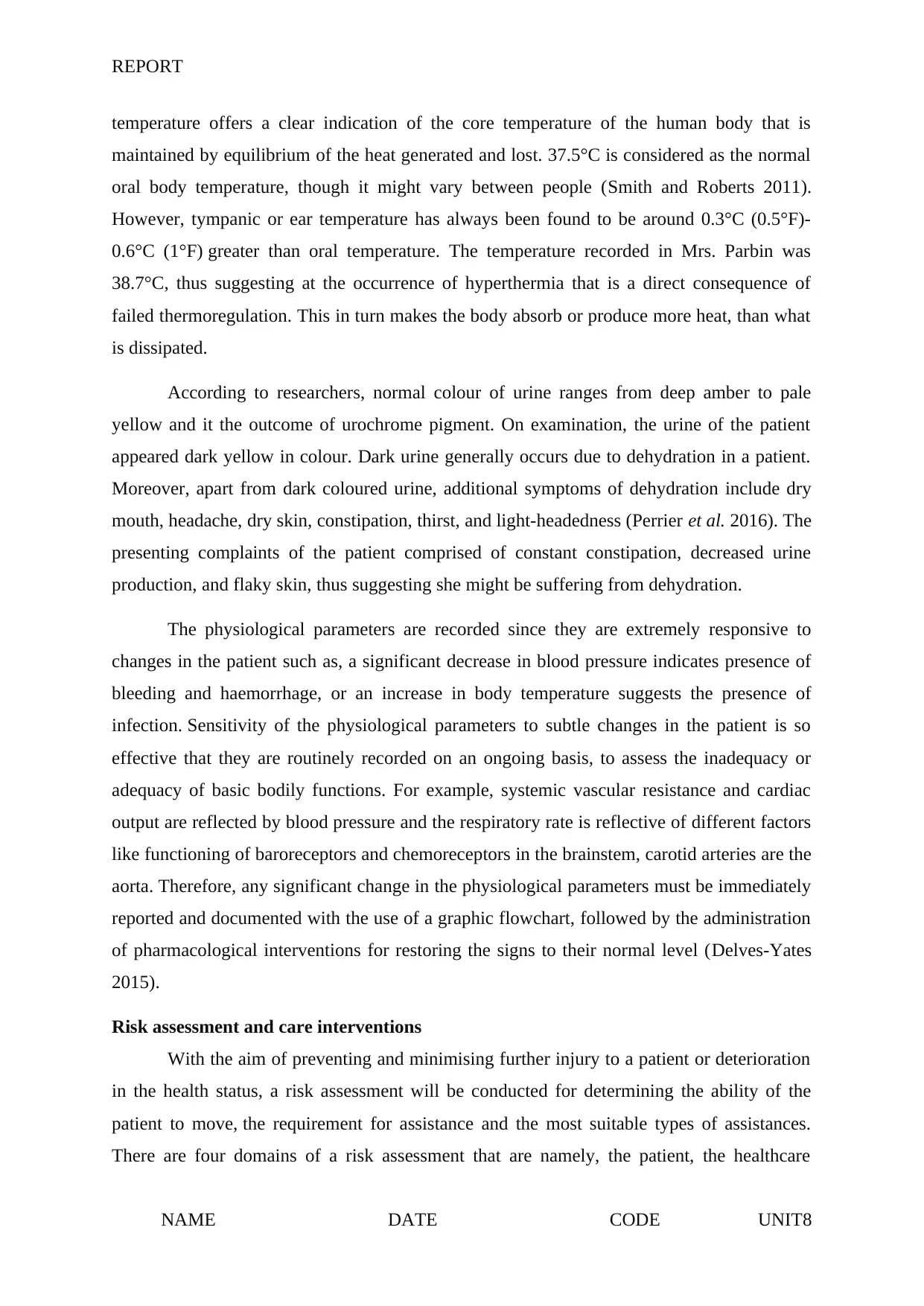
REPORT
temperature offers a clear indication of the core temperature of the human body that is
maintained by equilibrium of the heat generated and lost. 37.5°C is considered as the normal
oral body temperature, though it might vary between people (Smith and Roberts 2011).
However, tympanic or ear temperature has always been found to be around 0.3°C (0.5°F)-
0.6°C (1°F) greater than oral temperature. The temperature recorded in Mrs. Parbin was
38.7°C, thus suggesting at the occurrence of hyperthermia that is a direct consequence of
failed thermoregulation. This in turn makes the body absorb or produce more heat, than what
is dissipated.
According to researchers, normal colour of urine ranges from deep amber to pale
yellow and it the outcome of urochrome pigment. On examination, the urine of the patient
appeared dark yellow in colour. Dark urine generally occurs due to dehydration in a patient.
Moreover, apart from dark coloured urine, additional symptoms of dehydration include dry
mouth, headache, dry skin, constipation, thirst, and light-headedness (Perrier et al. 2016). The
presenting complaints of the patient comprised of constant constipation, decreased urine
production, and flaky skin, thus suggesting she might be suffering from dehydration.
The physiological parameters are recorded since they are extremely responsive to
changes in the patient such as, a significant decrease in blood pressure indicates presence of
bleeding and haemorrhage, or an increase in body temperature suggests the presence of
infection. Sensitivity of the physiological parameters to subtle changes in the patient is so
effective that they are routinely recorded on an ongoing basis, to assess the inadequacy or
adequacy of basic bodily functions. For example, systemic vascular resistance and cardiac
output are reflected by blood pressure and the respiratory rate is reflective of different factors
like functioning of baroreceptors and chemoreceptors in the brainstem, carotid arteries are the
aorta. Therefore, any significant change in the physiological parameters must be immediately
reported and documented with the use of a graphic flowchart, followed by the administration
of pharmacological interventions for restoring the signs to their normal level (Delves-Yates
2015).
Risk assessment and care interventions
With the aim of preventing and minimising further injury to a patient or deterioration
in the health status, a risk assessment will be conducted for determining the ability of the
patient to move, the requirement for assistance and the most suitable types of assistances.
There are four domains of a risk assessment that are namely, the patient, the healthcare
NAME DATE CODE UNIT8
temperature offers a clear indication of the core temperature of the human body that is
maintained by equilibrium of the heat generated and lost. 37.5°C is considered as the normal
oral body temperature, though it might vary between people (Smith and Roberts 2011).
However, tympanic or ear temperature has always been found to be around 0.3°C (0.5°F)-
0.6°C (1°F) greater than oral temperature. The temperature recorded in Mrs. Parbin was
38.7°C, thus suggesting at the occurrence of hyperthermia that is a direct consequence of
failed thermoregulation. This in turn makes the body absorb or produce more heat, than what
is dissipated.
According to researchers, normal colour of urine ranges from deep amber to pale
yellow and it the outcome of urochrome pigment. On examination, the urine of the patient
appeared dark yellow in colour. Dark urine generally occurs due to dehydration in a patient.
Moreover, apart from dark coloured urine, additional symptoms of dehydration include dry
mouth, headache, dry skin, constipation, thirst, and light-headedness (Perrier et al. 2016). The
presenting complaints of the patient comprised of constant constipation, decreased urine
production, and flaky skin, thus suggesting she might be suffering from dehydration.
The physiological parameters are recorded since they are extremely responsive to
changes in the patient such as, a significant decrease in blood pressure indicates presence of
bleeding and haemorrhage, or an increase in body temperature suggests the presence of
infection. Sensitivity of the physiological parameters to subtle changes in the patient is so
effective that they are routinely recorded on an ongoing basis, to assess the inadequacy or
adequacy of basic bodily functions. For example, systemic vascular resistance and cardiac
output are reflected by blood pressure and the respiratory rate is reflective of different factors
like functioning of baroreceptors and chemoreceptors in the brainstem, carotid arteries are the
aorta. Therefore, any significant change in the physiological parameters must be immediately
reported and documented with the use of a graphic flowchart, followed by the administration
of pharmacological interventions for restoring the signs to their normal level (Delves-Yates
2015).
Risk assessment and care interventions
With the aim of preventing and minimising further injury to a patient or deterioration
in the health status, a risk assessment will be conducted for determining the ability of the
patient to move, the requirement for assistance and the most suitable types of assistances.
There are four domains of a risk assessment that are namely, the patient, the healthcare
NAME DATE CODE UNIT8

REPORT
provider, the environment, and the organisation of work (Howatson-Jones et al. 2015).
While assessing Mrs. Pabin, her cooperativeness and capability to follow directions will be
evaluated by asking her to squeeze her hands and following cues. She will also be asked to
demonstrate her capability of bearing weight by bridging or lifting her legs off the bed,
following which she will again be asked to seat up on the edge of the bed without assistance.
Efforts will be taken to ensure whether the patient is able to sit forward without assistance
from the healthcare providers (Feller, Furin and Reynolds 2019). While assessing the
environment the presence of adequate space will be checked. It is also necessary to ensure
that all obstacles and harmful substances have been removed from the clinical setting to
prevent any incident of patient fall or self-harm (Abraham 2016). Assessment of the
workplace will encompass ensuring the presence of sufficient number of caregivers who will
devote adequate time. While assessing oneself in relation to providing care, a leader will be
designated for positioning or mobilizing the patient, and an empathetic and compassionate
approach will be adopted while conversing with in order to elevate her depressed mood.
While delivering care, the interventions will be respectful of the preferences of Mrs.
Pabin and responsiveness will also be demonstrated towards her values and requests. While
addressing the issue of dehydration, the patient will be advised to drink excess water,
particularly since she is suffering from constant constipation and less urine production.
Remaining hydrated will also help in treating her symptoms of hypotension that is neurally
mediated. Oral rehydration therapy will prove effective in addressing this physiological
abnormality by adding modest proportion of salts like potassium and sodium, along with
sugar to the bloodstream (Cheuvront et al. 2018).
She will be advised to take a break and get seated if she experiences signs of low
blood pressure after standing for long. The care plan will also focus on administration of
medications like fludrocortisone that will increase the blood volume and pressure by
augmenting the amount of sodium in the circulating bloodstream (Veazie et al. 2018). Since
she is suffering from hyperthermia, the room temperature will be adjusted to her real body
temperature and bed linens and blankets will be adjusted to regulate the temperature. Excess
clothing and covers will be eliminated that will decrease the volume and add to evaporative
cooling (Doughty, Lister and West-Oram 2015). She will also be administered antipyretic
medications for inhibiting the synthesis of prostaglandin that creates an impact on the
hypothalamus (Zimmermann and Curtis 2017).
NAME DATE CODE UNIT9
provider, the environment, and the organisation of work (Howatson-Jones et al. 2015).
While assessing Mrs. Pabin, her cooperativeness and capability to follow directions will be
evaluated by asking her to squeeze her hands and following cues. She will also be asked to
demonstrate her capability of bearing weight by bridging or lifting her legs off the bed,
following which she will again be asked to seat up on the edge of the bed without assistance.
Efforts will be taken to ensure whether the patient is able to sit forward without assistance
from the healthcare providers (Feller, Furin and Reynolds 2019). While assessing the
environment the presence of adequate space will be checked. It is also necessary to ensure
that all obstacles and harmful substances have been removed from the clinical setting to
prevent any incident of patient fall or self-harm (Abraham 2016). Assessment of the
workplace will encompass ensuring the presence of sufficient number of caregivers who will
devote adequate time. While assessing oneself in relation to providing care, a leader will be
designated for positioning or mobilizing the patient, and an empathetic and compassionate
approach will be adopted while conversing with in order to elevate her depressed mood.
While delivering care, the interventions will be respectful of the preferences of Mrs.
Pabin and responsiveness will also be demonstrated towards her values and requests. While
addressing the issue of dehydration, the patient will be advised to drink excess water,
particularly since she is suffering from constant constipation and less urine production.
Remaining hydrated will also help in treating her symptoms of hypotension that is neurally
mediated. Oral rehydration therapy will prove effective in addressing this physiological
abnormality by adding modest proportion of salts like potassium and sodium, along with
sugar to the bloodstream (Cheuvront et al. 2018).
She will be advised to take a break and get seated if she experiences signs of low
blood pressure after standing for long. The care plan will also focus on administration of
medications like fludrocortisone that will increase the blood volume and pressure by
augmenting the amount of sodium in the circulating bloodstream (Veazie et al. 2018). Since
she is suffering from hyperthermia, the room temperature will be adjusted to her real body
temperature and bed linens and blankets will be adjusted to regulate the temperature. Excess
clothing and covers will be eliminated that will decrease the volume and add to evaporative
cooling (Doughty, Lister and West-Oram 2015). She will also be administered antipyretic
medications for inhibiting the synthesis of prostaglandin that creates an impact on the
hypothalamus (Zimmermann and Curtis 2017).
NAME DATE CODE UNIT9
Secure Best Marks with AI Grader
Need help grading? Try our AI Grader for instant feedback on your assignments.
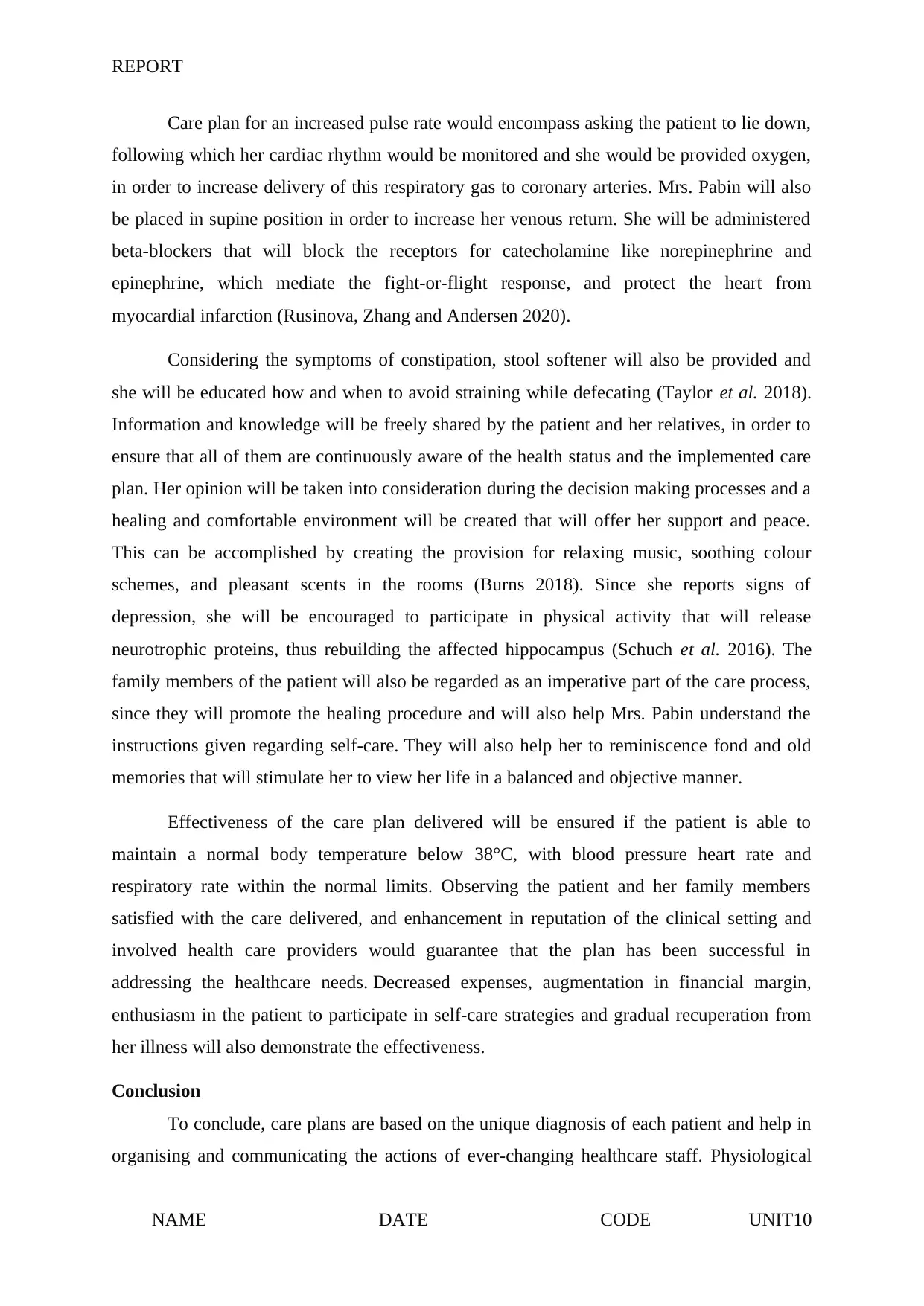
REPORT
Care plan for an increased pulse rate would encompass asking the patient to lie down,
following which her cardiac rhythm would be monitored and she would be provided oxygen,
in order to increase delivery of this respiratory gas to coronary arteries. Mrs. Pabin will also
be placed in supine position in order to increase her venous return. She will be administered
beta-blockers that will block the receptors for catecholamine like norepinephrine and
epinephrine, which mediate the fight-or-flight response, and protect the heart from
myocardial infarction (Rusinova, Zhang and Andersen 2020).
Considering the symptoms of constipation, stool softener will also be provided and
she will be educated how and when to avoid straining while defecating (Taylor et al. 2018).
Information and knowledge will be freely shared by the patient and her relatives, in order to
ensure that all of them are continuously aware of the health status and the implemented care
plan. Her opinion will be taken into consideration during the decision making processes and a
healing and comfortable environment will be created that will offer her support and peace.
This can be accomplished by creating the provision for relaxing music, soothing colour
schemes, and pleasant scents in the rooms (Burns 2018). Since she reports signs of
depression, she will be encouraged to participate in physical activity that will release
neurotrophic proteins, thus rebuilding the affected hippocampus (Schuch et al. 2016). The
family members of the patient will also be regarded as an imperative part of the care process,
since they will promote the healing procedure and will also help Mrs. Pabin understand the
instructions given regarding self-care. They will also help her to reminiscence fond and old
memories that will stimulate her to view her life in a balanced and objective manner.
Effectiveness of the care plan delivered will be ensured if the patient is able to
maintain a normal body temperature below 38°C, with blood pressure heart rate and
respiratory rate within the normal limits. Observing the patient and her family members
satisfied with the care delivered, and enhancement in reputation of the clinical setting and
involved health care providers would guarantee that the plan has been successful in
addressing the healthcare needs. Decreased expenses, augmentation in financial margin,
enthusiasm in the patient to participate in self-care strategies and gradual recuperation from
her illness will also demonstrate the effectiveness.
Conclusion
To conclude, care plans are based on the unique diagnosis of each patient and help in
organising and communicating the actions of ever-changing healthcare staff. Physiological
NAME DATE CODE UNIT10
Care plan for an increased pulse rate would encompass asking the patient to lie down,
following which her cardiac rhythm would be monitored and she would be provided oxygen,
in order to increase delivery of this respiratory gas to coronary arteries. Mrs. Pabin will also
be placed in supine position in order to increase her venous return. She will be administered
beta-blockers that will block the receptors for catecholamine like norepinephrine and
epinephrine, which mediate the fight-or-flight response, and protect the heart from
myocardial infarction (Rusinova, Zhang and Andersen 2020).
Considering the symptoms of constipation, stool softener will also be provided and
she will be educated how and when to avoid straining while defecating (Taylor et al. 2018).
Information and knowledge will be freely shared by the patient and her relatives, in order to
ensure that all of them are continuously aware of the health status and the implemented care
plan. Her opinion will be taken into consideration during the decision making processes and a
healing and comfortable environment will be created that will offer her support and peace.
This can be accomplished by creating the provision for relaxing music, soothing colour
schemes, and pleasant scents in the rooms (Burns 2018). Since she reports signs of
depression, she will be encouraged to participate in physical activity that will release
neurotrophic proteins, thus rebuilding the affected hippocampus (Schuch et al. 2016). The
family members of the patient will also be regarded as an imperative part of the care process,
since they will promote the healing procedure and will also help Mrs. Pabin understand the
instructions given regarding self-care. They will also help her to reminiscence fond and old
memories that will stimulate her to view her life in a balanced and objective manner.
Effectiveness of the care plan delivered will be ensured if the patient is able to
maintain a normal body temperature below 38°C, with blood pressure heart rate and
respiratory rate within the normal limits. Observing the patient and her family members
satisfied with the care delivered, and enhancement in reputation of the clinical setting and
involved health care providers would guarantee that the plan has been successful in
addressing the healthcare needs. Decreased expenses, augmentation in financial margin,
enthusiasm in the patient to participate in self-care strategies and gradual recuperation from
her illness will also demonstrate the effectiveness.
Conclusion
To conclude, care plans are based on the unique diagnosis of each patient and help in
organising and communicating the actions of ever-changing healthcare staff. Physiological
NAME DATE CODE UNIT10

REPORT
signs are considered imperative for rapid assessment of a patient when it is vital to evaluate
major alterations in the basic physiological functioning. Person-centred care is a conceptual
practice that will be delivered in order to maximize value, safety, comfort, and support of
Mrs. Pabin. Thus, it will encompass involving listening to and informing the patient in the
care process.
NAME DATE CODE UNIT11
signs are considered imperative for rapid assessment of a patient when it is vital to evaluate
major alterations in the basic physiological functioning. Person-centred care is a conceptual
practice that will be delivered in order to maximize value, safety, comfort, and support of
Mrs. Pabin. Thus, it will encompass involving listening to and informing the patient in the
care process.
NAME DATE CODE UNIT11
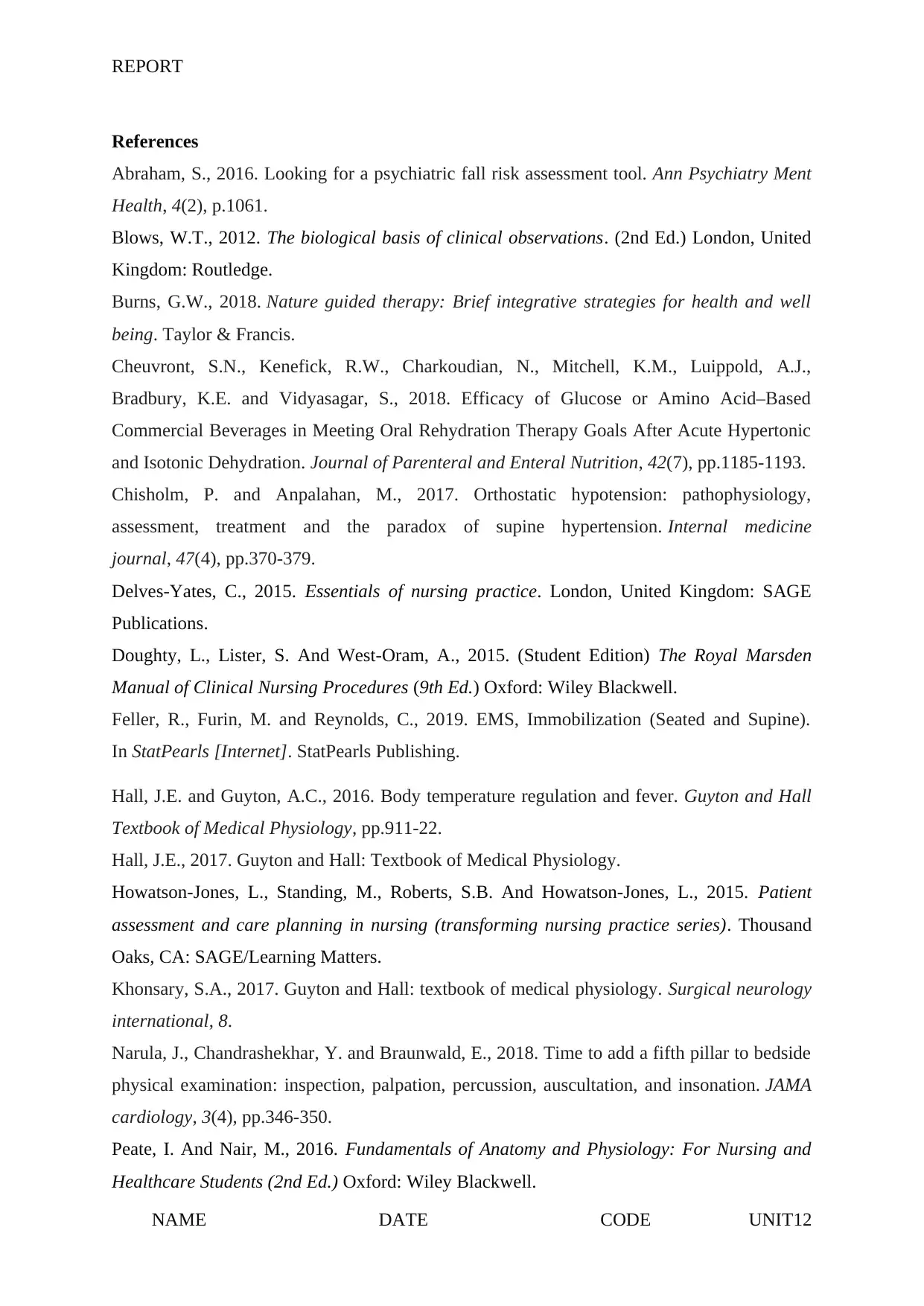
REPORT
References
Abraham, S., 2016. Looking for a psychiatric fall risk assessment tool. Ann Psychiatry Ment
Health, 4(2), p.1061.
Blows, W.T., 2012. The biological basis of clinical observations. (2nd Ed.) London, United
Kingdom: Routledge.
Burns, G.W., 2018. Nature guided therapy: Brief integrative strategies for health and well
being. Taylor & Francis.
Cheuvront, S.N., Kenefick, R.W., Charkoudian, N., Mitchell, K.M., Luippold, A.J.,
Bradbury, K.E. and Vidyasagar, S., 2018. Efficacy of Glucose or Amino Acid–Based
Commercial Beverages in Meeting Oral Rehydration Therapy Goals After Acute Hypertonic
and Isotonic Dehydration. Journal of Parenteral and Enteral Nutrition, 42(7), pp.1185-1193.
Chisholm, P. and Anpalahan, M., 2017. Orthostatic hypotension: pathophysiology,
assessment, treatment and the paradox of supine hypertension. Internal medicine
journal, 47(4), pp.370-379.
Delves-Yates, C., 2015. Essentials of nursing practice. London, United Kingdom: SAGE
Publications.
Doughty, L., Lister, S. And West-Oram, A., 2015. (Student Edition) The Royal Marsden
Manual of Clinical Nursing Procedures (9th Ed.) Oxford: Wiley Blackwell.
Feller, R., Furin, M. and Reynolds, C., 2019. EMS, Immobilization (Seated and Supine).
In StatPearls [Internet]. StatPearls Publishing.
Hall, J.E. and Guyton, A.C., 2016. Body temperature regulation and fever. Guyton and Hall
Textbook of Medical Physiology, pp.911-22.
Hall, J.E., 2017. Guyton and Hall: Textbook of Medical Physiology.
Howatson-Jones, L., Standing, M., Roberts, S.B. And Howatson-Jones, L., 2015. Patient
assessment and care planning in nursing (transforming nursing practice series). Thousand
Oaks, CA: SAGE/Learning Matters.
Khonsary, S.A., 2017. Guyton and Hall: textbook of medical physiology. Surgical neurology
international, 8.
Narula, J., Chandrashekhar, Y. and Braunwald, E., 2018. Time to add a fifth pillar to bedside
physical examination: inspection, palpation, percussion, auscultation, and insonation. JAMA
cardiology, 3(4), pp.346-350.
Peate, I. And Nair, M., 2016. Fundamentals of Anatomy and Physiology: For Nursing and
Healthcare Students (2nd Ed.) Oxford: Wiley Blackwell.
NAME DATE CODE UNIT12
References
Abraham, S., 2016. Looking for a psychiatric fall risk assessment tool. Ann Psychiatry Ment
Health, 4(2), p.1061.
Blows, W.T., 2012. The biological basis of clinical observations. (2nd Ed.) London, United
Kingdom: Routledge.
Burns, G.W., 2018. Nature guided therapy: Brief integrative strategies for health and well
being. Taylor & Francis.
Cheuvront, S.N., Kenefick, R.W., Charkoudian, N., Mitchell, K.M., Luippold, A.J.,
Bradbury, K.E. and Vidyasagar, S., 2018. Efficacy of Glucose or Amino Acid–Based
Commercial Beverages in Meeting Oral Rehydration Therapy Goals After Acute Hypertonic
and Isotonic Dehydration. Journal of Parenteral and Enteral Nutrition, 42(7), pp.1185-1193.
Chisholm, P. and Anpalahan, M., 2017. Orthostatic hypotension: pathophysiology,
assessment, treatment and the paradox of supine hypertension. Internal medicine
journal, 47(4), pp.370-379.
Delves-Yates, C., 2015. Essentials of nursing practice. London, United Kingdom: SAGE
Publications.
Doughty, L., Lister, S. And West-Oram, A., 2015. (Student Edition) The Royal Marsden
Manual of Clinical Nursing Procedures (9th Ed.) Oxford: Wiley Blackwell.
Feller, R., Furin, M. and Reynolds, C., 2019. EMS, Immobilization (Seated and Supine).
In StatPearls [Internet]. StatPearls Publishing.
Hall, J.E. and Guyton, A.C., 2016. Body temperature regulation and fever. Guyton and Hall
Textbook of Medical Physiology, pp.911-22.
Hall, J.E., 2017. Guyton and Hall: Textbook of Medical Physiology.
Howatson-Jones, L., Standing, M., Roberts, S.B. And Howatson-Jones, L., 2015. Patient
assessment and care planning in nursing (transforming nursing practice series). Thousand
Oaks, CA: SAGE/Learning Matters.
Khonsary, S.A., 2017. Guyton and Hall: textbook of medical physiology. Surgical neurology
international, 8.
Narula, J., Chandrashekhar, Y. and Braunwald, E., 2018. Time to add a fifth pillar to bedside
physical examination: inspection, palpation, percussion, auscultation, and insonation. JAMA
cardiology, 3(4), pp.346-350.
Peate, I. And Nair, M., 2016. Fundamentals of Anatomy and Physiology: For Nursing and
Healthcare Students (2nd Ed.) Oxford: Wiley Blackwell.
NAME DATE CODE UNIT12
Paraphrase This Document
Need a fresh take? Get an instant paraphrase of this document with our AI Paraphraser

REPORT
Perrier, E.T., Johnson, E.C., McKenzie, A.L., Ellis, L.A. and Armstrong, L.E., 2016. Urine
colour change as an indicator of change in daily water intake: a quantitative
analysis. European journal of nutrition, 55(5), pp.1943-1949.
Rusinova, R., Zhang, K. and Andersen, O.S., 2020. Beta-Blockers Alter Lipid Bilayer
Properties. Biophysical Journal, 118(3), p.381a.
Scanlon, V.C. and Sanders, T., 2018. Essentials of anatomy and physiology. FA Davis.
Schuch, F.B., Vancampfort, D., Richards, J., Rosenbaum, S., Ward, P.B. and Stubbs, B.,
2016. Exercise as a treatment for depression: a meta-analysis adjusting for publication
bias. Journal of psychiatric research, 77, pp.42-51.
Smith, J. And Roberts, R., 2011. Vital signs for nurses: An Introduction to clinical
observations. Oxford: Wiley Blackwell
Taylor, D.C., Abel, J.L., Martin, C., Hunter, A.G., Essoi, B., Korrer, S., Reasner, D.S. and
Chey, W.D., 2018. Treatment Patterns, Over-the-Counter (OTC) Use, and Outcomes Among
Patients With Irritable Bowel Syndrome With Constipation or Chronic Idiopathic
Constipation: Results from the CONTOR Study: 423. American Journal of
Gastroenterology, 113, pp.S249-S250.
Tortora, G.J. and Derrickson, B.H., 2018. Principles of anatomy and physiology. John Wiley
& Sons.
Veazie, S., Peterson, K., Ansari, Y., Chung, K.A., Gibbons, C.H., Raj, S.R. and Helfand, M.,
2017. Fludrocortisone for orthostatic hypotension. The Cochrane Database of Systematic
Reviews, 2017(12).
Waugh, A. And Grant, A., 2014. Ross and Wilson Anatomy and Physiology in Health and
Illness (12th Ed.) London: Churchill Livingstone Elsevier.Publishers.
Zimmermann, P. and Curtis, N., 2017. Antimicrobial effects of antipyretics. Antimicrobial
agents and chemotherapy, 61(4), pp.e02268-16.
NAME DATE CODE UNIT13
Perrier, E.T., Johnson, E.C., McKenzie, A.L., Ellis, L.A. and Armstrong, L.E., 2016. Urine
colour change as an indicator of change in daily water intake: a quantitative
analysis. European journal of nutrition, 55(5), pp.1943-1949.
Rusinova, R., Zhang, K. and Andersen, O.S., 2020. Beta-Blockers Alter Lipid Bilayer
Properties. Biophysical Journal, 118(3), p.381a.
Scanlon, V.C. and Sanders, T., 2018. Essentials of anatomy and physiology. FA Davis.
Schuch, F.B., Vancampfort, D., Richards, J., Rosenbaum, S., Ward, P.B. and Stubbs, B.,
2016. Exercise as a treatment for depression: a meta-analysis adjusting for publication
bias. Journal of psychiatric research, 77, pp.42-51.
Smith, J. And Roberts, R., 2011. Vital signs for nurses: An Introduction to clinical
observations. Oxford: Wiley Blackwell
Taylor, D.C., Abel, J.L., Martin, C., Hunter, A.G., Essoi, B., Korrer, S., Reasner, D.S. and
Chey, W.D., 2018. Treatment Patterns, Over-the-Counter (OTC) Use, and Outcomes Among
Patients With Irritable Bowel Syndrome With Constipation or Chronic Idiopathic
Constipation: Results from the CONTOR Study: 423. American Journal of
Gastroenterology, 113, pp.S249-S250.
Tortora, G.J. and Derrickson, B.H., 2018. Principles of anatomy and physiology. John Wiley
& Sons.
Veazie, S., Peterson, K., Ansari, Y., Chung, K.A., Gibbons, C.H., Raj, S.R. and Helfand, M.,
2017. Fludrocortisone for orthostatic hypotension. The Cochrane Database of Systematic
Reviews, 2017(12).
Waugh, A. And Grant, A., 2014. Ross and Wilson Anatomy and Physiology in Health and
Illness (12th Ed.) London: Churchill Livingstone Elsevier.Publishers.
Zimmermann, P. and Curtis, N., 2017. Antimicrobial effects of antipyretics. Antimicrobial
agents and chemotherapy, 61(4), pp.e02268-16.
NAME DATE CODE UNIT13
1 out of 14
Related Documents
Your All-in-One AI-Powered Toolkit for Academic Success.
+13062052269
info@desklib.com
Available 24*7 on WhatsApp / Email
![[object Object]](/_next/static/media/star-bottom.7253800d.svg)
Unlock your academic potential
© 2024 | Zucol Services PVT LTD | All rights reserved.





